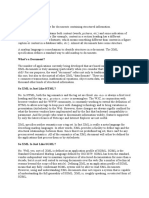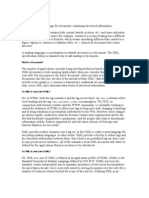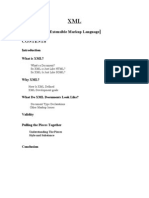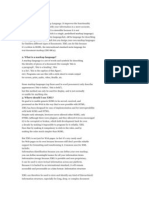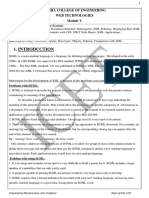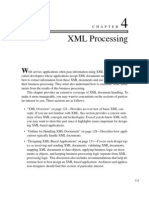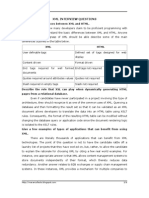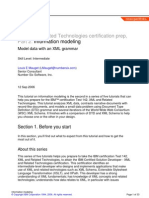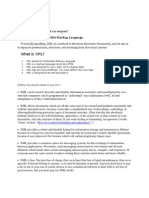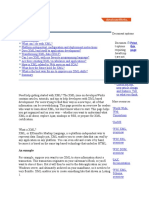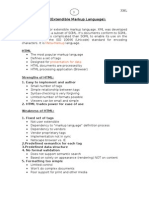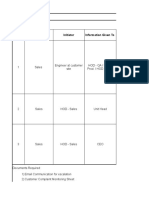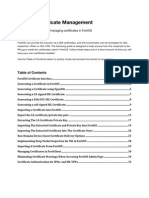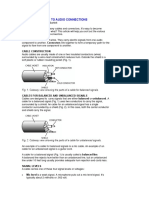0 ratings0% found this document useful (0 votes)
35 viewsTechnical X ML
Technical X ML
Uploaded by
Yesenia RomanXML is a markup language for documents containing structured information. This article presents the language at a reasonably technical level for anyone interested in structured documents. The article is organized in four main sections plus an appendix.
Copyright:
© All Rights Reserved
Available Formats
Download as PDF, TXT or read online from Scribd
Technical X ML
Technical X ML
Uploaded by
Yesenia Roman0 ratings0% found this document useful (0 votes)
35 views20 pagesXML is a markup language for documents containing structured information. This article presents the language at a reasonably technical level for anyone interested in structured documents. The article is organized in four main sections plus an appendix.
Original Title
Technical x Ml
Copyright
© © All Rights Reserved
Available Formats
PDF, TXT or read online from Scribd
Share this document
Did you find this document useful?
Is this content inappropriate?
XML is a markup language for documents containing structured information. This article presents the language at a reasonably technical level for anyone interested in structured documents. The article is organized in four main sections plus an appendix.
Copyright:
© All Rights Reserved
Available Formats
Download as PDF, TXT or read online from Scribd
Download as pdf or txt
0 ratings0% found this document useful (0 votes)
35 views20 pagesTechnical X ML
Technical X ML
Uploaded by
Yesenia RomanXML is a markup language for documents containing structured information. This article presents the language at a reasonably technical level for anyone interested in structured documents. The article is organized in four main sections plus an appendix.
Copyright:
© All Rights Reserved
Available Formats
Download as PDF, TXT or read online from Scribd
Download as pdf or txt
You are on page 1of 20
8/26/2014 XML.
com: A Technical Introduction to XML
http://www.xml.com/lpt/a/316 1/20
Published on XML.com http://www.xml.com/pub/a/98/10/guide0.html
See this if you're having trouble printing code examples
A Technical Introduction to XML
By Norman Walsh
October 03, 1998
Author's Note: It is somewhat remarkable to think that this article, which appeared initially in the Winter
1997 edition of the World Wide Web Journal was out of date by the time the final XML Recommendation
was approved in February. And even as this update brings the article back into line with the final spec, a
new series of recommendations are under development. When finished, these will bring namespaces,
linking, schemas, stylesheets, and more to the table.
This introduction to XML presents the Extensible Markup Language at a reasonably technical level for
anyone interested in learning more about structured documents. In addition to covering the XML 1.0
Specification, this article outlines related XML specifications, which are evolving. The article is organized
in four main sections plus an appendix.
Start Here
What is XML?
What's a Document?
So XML is Just Like HTML?
So XML Is Just Like SGML?
Why XML?
XML Development Goals
How Is XML Defined?
Understanding the Specs
What Do XML Documents Look Like?
Elements
Entity References
Comments
Processing Instructions
CDATA Sections
Document Type Declarations
Other Markup Issues
Validity
Well-formed Documents
Valid Documents
Pulling the Pieces Together
8/26/2014 XML.com: A Technical Introduction to XML
http://www.xml.com/lpt/a/316 2/20
Simple Links
Extended Links
Extended Pointers
Extended Link Group
Understanding The Pieces
Style and Substance
Conclusion
Appendix:
Extended Backus-Naur Form (EBNF)
Revision History
What is XML?
XML is a markup language for documents containing structured information.
Structured information contains both content (words, pictures, etc.) and some indication of what role that
content plays (for example, content in a section heading has a different meaning from content in a footnote,
which means something different than content in a figure caption or content in a database table, etc.).
Almost all documents have some structure.
A markup language is a mechanism to identify structures in a document. The XML specification defines a
standard way to add markup to documents.
What's a Document?
The number of applications currently being developed that are based on, or make use of, XML documents
is truly amazing (particularly when you consider that XML is not yet a year old)! For our purposes, the
word "document" refers not only to traditional documents, like this one, but also to the myriad of other
XML "data formats". These include vector graphics, e-commerce transactions, mathematical equations,
object meta-data, server APIs, and a thousand other kinds of structured information.
So XML is Just Like HTML?
No. In HTML, both the tag semantics and the tag set are fixed. An <h1> is always a first level heading and
the tag <ati.product.code> is meaningless. The W3C, in conjunction with browser vendors and the
WWW community, is constantly working to extend the definition of HTML to allow new tags to keep pace
with changing technology and to bring variations in presentation (stylesheets) to the Web. However, these
changes are always rigidly confined by what the browser vendors have implemented and by the fact that
backward compatibility is paramount. And for people who want to disseminate information widely, features
supported by only the latest releases of Netscape and Internet Explorer are not useful.
XML specifies neither semantics nor a tag set. In fact XML is really a meta-language for describing markup
8/26/2014 XML.com: A Technical Introduction to XML
http://www.xml.com/lpt/a/316 3/20
languages. In other words, XML provides a facility to define tags and the structural relationships between
them. Since there's no predefined tag set, there can't be any preconceived semantics. All of the semantics of
an XML document will either be defined by the applications that process them or by stylesheets.
So XML Is Just Like SGML?
No. Well, yes, sort of. XML is defined as an application profile of SGML. SGML is the Standard
Generalized Markup Language defined by ISO 8879. SGML has been the standard, vendor-independent
way to maintain repositories of structured documentation for more than a decade, but it is not well suited to
serving documents over the web (for a number of technical reasons beyond the scope of this article).
Defining XML as an application profile of SGML means that any fully conformant SGML system will be
able to read XML documents. However, using and understanding XML documents does not require a
system that is capable of understanding the full generality of SGML. XML is, roughly speaking, a restricted
form of SGML.
For technical purists, it's important to note that there may also be subtle differences between documents as
understood by XML systems and those same documents as understood by SGML systems. In particular,
treatment of white space immediately adjacent to tags may be different.
Why XML?
In order to appreciate XML, it is important to understand why it was created. XML was created so that
richly structured documents could be used over the web. The only viable alternatives, HTML and SGML,
are not practical for this purpose.
HTML, as we've already discussed, comes bound with a set of semantics and does not provide arbitrary
structure.
SGML provides arbitrary structure, but is too difficult to implement just for a web browser. Full SGML
systems solve large, complex problems that justify their expense. Viewing structured documents sent over
the web rarely carries such justification.
This is not to say that XML can be expected to completely replace SGML. While XML is being designed
to deliver structured content over the web, some of the very features it lacks to make this practical, make
SGML a more satisfactory solution for the creation and long-time storage of complex documents. In many
organizations, filtering SGML to XML will be the standard procedure for web delivery.
XML Development Goals
The XML specification sets out the following goals for XML: [Section 1.1] (In this article, citations of the
form [Section 1.1], these are references to the W3C Recommendation Extensible Markup Language (XML)
1.0. If you are interested in more technical detail about a particular topic, please consult the specification)
1. It shall be straightforward to use XML over the Internet. Users must be able to view XML documents
as quickly and easily as HTML documents. In practice, this will only be possible when XML
browsers are as robust and widely available as HTML browsers, but the principle remains.
2. XML shall support a wide variety of applications. XML should be beneficial to a wide variety of
diverse applications: authoring, browsing, content analysis, etc. Although the initial focus is on
serving structured documents over the web, it is not meant to narrowly define XML.
3. XML shall be compatible with SGML. Most of the people involved in the XML effort come from
8/26/2014 XML.com: A Technical Introduction to XML
http://www.xml.com/lpt/a/316 4/20
organizations that have a large, in some cases staggering, amount of material in SGML. XML was
designed pragmatically, to be compatible with existing standards while solving the relatively new
problem of sending richly structured documents over the web.
4. It shall be easy to write programs that process XML documents. The colloquial way of expressing
this goal while the spec was being developed was that it ought to take about two weeks for a
competent computer science graduate student to build a program that can process XML documents.
5. The number of optional features in XML is to be kept to an absolute minimum, ideally zero. Optional
features inevitably raise compatibility problems when users want to share documents and sometimes
lead to confusion and frustration.
6. XML documents should be human-legible and reasonably clear. If you don't have an XML browser
and you've received a hunk of XML from somewhere, you ought to be able to look at it in your
favorite text editor and actually figure out what the content means.
7. The XML design should be prepared quickly. Standards efforts are notoriously slow. XML was
needed immediately and was developed as quickly as possible.
8. The design of XML shall be formal and concise. In many ways a corollary to rule 4, it essentially
means that XML must be expressed in EBNF and must be amenable to modern compiler tools and
techniques.
There are a number of technical reasons why the SGML grammar cannot be expressed in EBNF.
Writing a proper SGML parser requires handling a variety of rarely used and difficult to parse
language features. XML does not.
9. XML documents shall be easy to create. Although there will eventually be sophisticated editors to
create and edit XML content, they won't appear immediately. In the interim, it must be possible to
create XML documents in other ways: directly in a text editor, with simple shell and Perl scripts, etc.
10. Terseness in XML markup is of minimal importance. Several SGML language features were
designed to minimize the amount of typing required to manually key in SGML documents. These
features are not supported in XML. From an abstract point of view, these documents are
indistinguishable from their more fully specified forms, but supporting these features adds a
considerable burden to the SGML parser (or the person writing it, anyway). In addition, most modern
editors offer better facilities to define shortcuts when entering text.
How Is XML Defined?
XML is defined by a number of related specifications:
Extensible Markup Language (XML) 1.0
Defines the syntax of XML. The XML specification is the primary focus of this article.
XML Pointer Language (XPointer) and XML Linking Language (XLink)
Defines a standard way to represent links between resources. In addition to simple links, like HTML's
<A> tag, XML has mechanisms for links between multiple resources and links between read-only
resources. XPointer describes how to address a resource, XLink describes how to associate two or
more resources.
Extensible Style Language (XSL)
Defines the standard stylesheet language for XML.
As time goes on, additional requirements will be addressed by other specifications. Currently (Sep, 1998),
namespaces (dealing with tags from multiple tag sets), a query language (finding out what's in a document
or a collection of documents), and a schema language (describing the relationships between tags, DTDs in
XML) are all being actively pursued.
Understanding the Specs
8/26/2014 XML.com: A Technical Introduction to XML
http://www.xml.com/lpt/a/316 5/20
For the most part, reading and understanding the XML specifications does not require extensive knowledge
of SGML or any of the related technologies.
One topic that may be new is the use of EBNF to describe the syntax of XML. Please consult the
discussion of EBNF in the appendix of this article for a detailed description of how this grammar works.
What Do XML Documents Look Like?
If you are conversant with HTML or SGML, XML documents will look familiar. A simple XML document
is presented in Example 1.
Example 1. A Simple XML Document
<?xml version="1.0"?>
<oldjoke>
<burns>Say <quote>goodnight</quote>,
Gracie.</burns>
<allen><quote>Goodnight,
Gracie.</quote></allen>
<applause/>
</oldjoke>
A few things may stand out to you:
The document begins with a processing instruction: <?xml ...?>. This is the XML declaration
[Section 2.8]. While it is not required, its presence explicitly identifies the document as an XML
document and indicates the version of XML to which it was authored.
There's no document type declaration. Unlike SGML, XML does not require a document type
declaration. However, a document type declaration can be supplied, and some documents will require
one in order to be understood unambiguously.
Empty elements (<applause/> in this example) have a modified syntax [Section 3.1]. While most
elements in a document are wrappers around some content, empty elements are simply markers where
something occurs (a horizontal rule for HTML's <hr> tag, for example, or a cross reference for
DocBook's <xref> tag). The trailing /> in the modified syntax indicates to a program processing the
XML document that the element is empty and no matching end-tag should be sought. Since XML
documents do not require a document type declaration, without this clue it could be impossible for an
XML parser to determine which tags were intentionally empty and which had been left empty by
mistake.
XML has softened the distinction between elements which are declared as EMPTY and elements which
merely have no content. In XML, it is legal to use the empty-element tag syntax in either case. It's
also legal to use a start-tag/end-tag pair for empty elements: <applause></applause>. If
interoperability is of any concern, it's best to reserve empty-element tag syntax for elements which are
8/26/2014 XML.com: A Technical Introduction to XML
http://www.xml.com/lpt/a/316 6/20
declared as EMPTY and to only use the empty-element tag form for those elements.
XML documents are composed of markup and content. There are six kinds of markup that can occur in an
XML document: elements, entity references, comments, processing instructions, marked sections, and
document type declarations. The following sections introduce each of these markup concepts.
Elements
Elements are the most common form of markup. Delimited by angle brackets, most elements identify the
nature of the content they surround. Some elements may be empty, as seen above, in which case they have
no content. If an element is not empty, it begins with a start-tag, <element>, and ends with an end-tag,
</element>.
Attributes
Attributes are name-value pairs that occur inside start-tags after the element name. For example,
<div class="preface">
is a div element with the attribute class having the value preface. In XML, all attribute values must be
quoted.
Entity References
In order to introduce markup into a document, some characters have been reserved to identify the start of
markup. The left angle bracket, < , for instance, identifies the beginning of an element start- or end-tag. In
order to insert these characters into your document as content, there must be an alternative way to represent
them. In XML, entities are used to represent these special characters. Entities are also used to refer to often
repeated or varying text and to include the content of external files.
Every entity must have a unique name. Defining your own entity names is discussed in the section on entity
declarations. In order to use an entity, you simply reference it by name. Entity references begin with the
ampersand and end with a semicolon.
For example, the lt entity inserts a literal < into a document. So the string <element> can be represented in
an XML document as <element>.
A special form of entity reference, called a character reference [Section 4.1], can be used to insert arbitrary
Unicode characters into your document. This is a mechanism for inserting characters that cannot be typed
directly on your keyboard.
Character references take one of two forms: decimal references, ℞, and hexadecimal references,
℞. Both of these refer to character number U+211E from Unicode (which is the standard Rx
prescription symbol, in case you were wondering).
Comments
Comments begin with <!-- and end with -->. Comments can contain any data except the literal string --.
You can place comments between markup anywhere in your document.
8/26/2014 XML.com: A Technical Introduction to XML
http://www.xml.com/lpt/a/316 7/20
Comments are not part of the textual content of an XML document. An XML processor is not required to
pass them along to an application.
Processing Instructions
Processing instructions (PIs) are an escape hatch to provide information to an application. Like comments,
they are not textually part of the XML document, but the XML processor is required to pass them to an
application.
Processing instructions have the form: <?name pidata?>. The name, called the PI target, identifies the PI
to the application. Applications should process only the targets they recognize and ignore all other PIs. Any
data that follows the PI target is optional, it is for the application that recognizes the target. The names used
in PIs may be declared as notations in order to formally identify them.
PI names beginning with xml are reserved for XML standardization.
CDATA Sections
In a document, a CDATA section instructs the parser to ignore most markup characters.
Consider a source code listing in an XML document. It might contain characters that the XML parser would
ordinarily recognize as markup (< and &, for example). In order to prevent this, a CDATA section can be
used.
<![CDATA[
*p = &q;
b = (i <= 3);
]]>
Between the start of the section, <![CDATA[ and the end of the section, ]]>, all character data is passed
directly to the application, without interpretation. Elements, entity references, comments, and processing
instructions are all unrecognized and the characters that comprise them are passed literally to the application.
The only string that cannot occur in a CDATA section is ]]>.
Document Type Declarations
A large percentage of the XML specification deals with various sorts of declarations that are allowed in
XML. If you have experience with SGML, you will recognize these declarations from SGML DTDs
(Document Type Definitions). If you have never seen them before, their significance may not be
immediately obvious.
One of the greatest strengths of XML is that it allows you to create your own tag names. But for any given
application, it is probably not meaningful for tags to occur in a completely arbitrary order. Consider the old
joke example introduced earlier. Would this be meaningful?
<gracie><quote><oldjoke>Goodnight,
<applause/>Gracie</oldjoke></quote>
8/26/2014 XML.com: A Technical Introduction to XML
http://www.xml.com/lpt/a/316 8/20
<burns><gracie>Say <quote>goodnight</quote>,
</gracie>Gracie.</burns></gracie>
It's so far outside the bounds of what we normally expect that it's nonsensical. It just doesn't mean anything.
However, from a strictly syntactic point of view, there's nothing wrong with that XML document. So, if the
document is to have meaning, and certainly if you're writing a stylesheet or application to process it, there
must be some constraint on the sequence and nesting of tags. Declarations are where these constraints can
be expressed.
More generally, declarations allow a document to communicate meta-information to the parser about its
content. Meta-information includes the allowed sequence and nesting of tags, attribute values and their types
and defaults, the names of external files that may be referenced and whether or not they contain XML, the
formats of some external (non-XML) data that may be referenced, and the entities that may be encountered.
There are four kinds of declarations in XML: element type declarations, attribute list declarations, entity
declarations, and notation declarations.
Element Type Declarations
Element type declarations [Section 3.2] identify the names of elements and the nature of their content. A
typical element type declaration looks like this:
<!ELEMENT oldjoke (burns+, allen, applause?)>
This declaration identifies the element named oldjoke. Its content model follows the element name. The
content model defines what an element may contain. In this case, an oldjoke must contain burns and
allen and may contain applause. The commas between element names indicate that they must occur in
succession. The plus after burns indicates that it may be repeated more than once but must occur at least
once. The question mark after applause indicates that it is optional (it may be absent, or it may occur
exactly once). A name with no punctuation, such as allen, must occur exactly once.
Declarations for burns, allen, applause and all other elements used in any content model must also be
present for an XML processor to check the validity of a document.
In addition to element names, the special symbol #PCDATA is reserved to indicate character data. The
moniker PCDATA stands for parseable character data .
Elements that contain only other elements are said to have element content [Section 3.2.1]. Elements that
contain both other elements and #PCDATA are said to have mixed content [Section 3.2.2].
For example, the definition for burns might be
<!ELEMENT burns (#PCDATA | quote)*>
The vertical bar indicates an or relationship, the asterisk indicates that the content is optional (may occur
zero or more times); therefore, by this definition, burns may contain zero or more characters and quote
tags, mixed in any order. All mixed content models must have this form: #PCDATA must come first, all of the
elements must be separated by vertical bars, and the entire group must be optional.
8/26/2014 XML.com: A Technical Introduction to XML
http://www.xml.com/lpt/a/316 9/20
Two other content models are possible: EMPTY indicates that the element has no content (and consequently
no end-tag), and ANY indicates that any content is allowed. The ANY content model is sometimes useful
during document conversion, but should be avoided at almost any cost in a production environment because
it disables all content checking in that element.
Here is a complete set of element declarations for Example 1:
Example 2. Element Declarations for Old Jokes
<!ELEMENT oldjoke (burns+, allen, applause?)>
<!ELEMENT burns (#PCDATA | quote)*>
<!ELEMENT allen (#PCDATA | quote)*>
<!ELEMENT quote (#PCDATA)*>
<!ELEMENT applause EMPTY>
Attribute List Declarations
Attribute list declarations [Section 3.3] identify which elements may have attributes, what attributes they
may have, what values the attributes may hold, and what value is the default. A typical attribute list
declaration looks like this:
<!ATTLIST oldjoke
name
ID
#REQUIRED
label
CDATA
#IMPLIED
status ( funny | notfunny ) 'funny'>
In this example, the oldjoke element has three attributes: name, which is an ID and is required; label,
which is a string (character data) and is not required; and status, which must be either funny or notfunny
and defaults to funny, if no value is specified.
Each attribute in a declaration has three parts: a name, a type, and a default value.
You are free to select any name you wish, subject to some slight restrictions [Section 2.3, production 5], but
names cannot be repeated on the same element.
There are six possible attribute types:
CDATA
CDATA attributes are strings, any text is allowed. Don't confuse CDATA attributes with CDATA
sections, they are unrelated.
ID
The value of an ID attribute must be a name [Section 2.3, production 5]. All of the ID values used in
8/26/2014 XML.com: A Technical Introduction to XML
http://www.xml.com/lpt/a/316 10/20
a document must be different. IDs uniquely identify individual elements in a document. Elements can
have only a single ID attribute.
IDREF
or IDREFS
An IDREF attribute's value must be the value of a single ID attribute on some element in the
document. The value of an IDREFS attribute may contain multiple IDREF values separated by white
space [Section 2.3, production 3].
ENTITY
or ENTITIES
An ENTITY attribute's value must be the name of a single entity (see the discussion of entity
declarations below). The value of an ENTITIES attribute may contain multiple entity names
separated by white space.
NMTOKEN
or NMTOKENS
Name token attributes are a restricted form of string attribute. In general, an NMTOKEN attribute
must consist of a single word [Section 2.3, production 7], but there are no additional constraints on
the word, it doesn't have to match another attribute or declaration. The value of an NMTOKENS
attribute may contain multiple NMTOKEN values separated by white space.
A list of names
You can specify that the value of an attribute must be taken from a specific list of names. This is
frequently called an enumerated type because each of the possible values is explicitly enumerated in
the declaration.
Alternatively, you can specify that the names must match a notation name (see the discussion of
notation declarations below).
There are four possible default values:
#REQUIRED
The attribute must have an explicitly specified value on every occurrence of the element in the
document.
#IMPLIED
The attribute value is not required, and no default value is provided. If a value is not specified, the
XML processor must proceed without one.
"value"
An attribute can be given any legal value as a default. The attribute value is not required on each
element in the document, and if it is not present, it will appear to be the specified default.
#FIXED
"value"
An attribute declaration may specify that an attribute has a fixed value. In this case, the attribute is not
required, but if it occurs, it must have the specified value. If it is not present, it will appear to be the
specified default. One use for fixed attributes is to associate semantics with an element. A complete
discussion is beyond the scope of this article, but you can find several examples of fixed attributes in
the XLink specification.
The XML processer performs attribute value normalization [Section 3.3.3] on attribute values: character
references are replaced by the referenced character, entity references are resolved (recursively), and
whitespace is normalized.
Entity Declarations
Entity declarations [Section 4.2] allow you to associate a name with some other fragment of content. That
construct can be a chunk of regular text, a chunk of the document type declaration, or a reference to an
8/26/2014 XML.com: A Technical Introduction to XML
http://www.xml.com/lpt/a/316 11/20
external file containing either text or binary data.
A few typical entity declarations are shown in Example 3.
Example 3. Typical Entity Declarations
<!ENTITY
ATI
"ArborText, Inc.">
<!ENTITY boilerplate SYSTEM
"/standard/legalnotice.xml">
<!ENTITY ATIlogo
SYSTEM "/standard/logo.gif" NDATA GIF87A>
There are three kinds of entities:
Internal Entities
Internal entities [Section 4.2.1] associate a name with a string of literal text. The first entity in
Example 3 is an internal entity. Using &ATI; anywhere in the document will insert ArborText, Inc. at
that location. Internal entities allow you to define shortcuts for frequently typed text or text that is
expected to change, such as the revision status of a document.
Internal entities can include references to other internal entities, but it is an error for them to be recursive.
The XML specification predefines five internal entities:
< produces the left angle bracket, <
> produces the right angle bracket, >
& produces the ampersand, &
' produces a single quote character (an apostrophe), '
" produces a double quote character, "
External Entities
External entities [Section 4.2.2] associate a name with the content of another file. External entities
allow an XML document to refer to the contents of another file. External entities contain either text or
binary data. If they contain text, the content of the external file is inserted at the point of reference and
parsed as part of the referring document. Binary data is not parsed and may only be referenced in an
attribute. Binary data is used to reference figures and other non-XML content in the document.
The second and third entities in Example 3 are external entities.
Using &boilerplate; will have insert the contents of the file /standard/legalnotice.xml at the
location of the entity reference. The XML processor will parse the content of that file as if it occurred
literally at that location.
The entity ATIlogo is also an external entity, but its content is binary. The ATIlogo entity can only
be used as the value of an ENTITY (or ENTITIES) attribute (on a graphic element, perhaps). The
XML processor will pass this information along to an application, but it does not attempt to process
the content of /standard/logo.gif.
Parameter Entities
Parameter entities can only occur in the document type declaration. A parameter entity declaration is
identified by placing % (percent-space) in front of its name in the declaration. The percent sign is also
8/26/2014 XML.com: A Technical Introduction to XML
http://www.xml.com/lpt/a/316 12/20
used in references to parameter entities, instead of the ampersand. Parameter entity references are
immediately expanded in the document type declaration and their replacement text is part of the
declaration, whereas normal entity references are not expanded. Parameter entities are not recognized
in the body of a document.
Looking back at the element declarations in Example 2, you'll notice that two of them have the same
content model:
<!ELEMENT burns (#PCDATA | quote)*>
<!ELEMENT allen (#PCDATA | quote)*>
At the moment, these two elements are the same only because they happen to have the same literal
definition. In order to make more explicit the fact that these two elements are semantically the same,
use a parameter entity to define their content model. The advantage of using a parameter entity is two-
fold. First, it allows you to give a descriptive name to the content, and second it allows you to change
the content model in only a single place, if you wish to update the element declarations, assuring that
they always stay the same:
<!ENTITY % personcontent "#PCDATA | quote">
<!ELEMENT burns (%personcontent;)*>
<!ELEMENT allen (%personcontent;)*>
Notation Declarations
Notation declarations [Section 4.7] identify specific types of external binary data. This information is passed
to the processing application, which may make whatever use of it it wishes. A typical notation declaration
is:
<!NOTATION GIF87A SYSTEM "GIF">
Do I need a Document Type Declaration?
As we've seen, XML content can be processed without a document type declaration. However, there are
some instances where the declaration is required:
Authoring Environments
Most authoring environments need to read and process document type declarations in order to
understand and enforce the content models of the document.
Default Attribute Values
If an XML document relies on default attribute values, at least part of the declaration must be
processed in order to obtain the correct default values.
White Space Handling
The semantics associated with white space in element content differs from the semantics associated
with white space in mixed content. Without a DTD, there is no way for the processor to distinguish
between these cases, and all elements are effectively mixed content. For more detail, see the section
called White Space Handling, later in this document.
In applications where a person composes or edits the data (as opposed to data that may be generated directly
from a database, for example), a DTD is probably going to be required if any structure is to be guaranteed.
8/26/2014 XML.com: A Technical Introduction to XML
http://www.xml.com/lpt/a/316 13/20
Including a Document Type Declaration
If present, the document type declaration must be the first thing in the document after optional processing
instructions and comments [Section 2.8].
The document type declaration identifies the root element of the document and may contain additional
declarations. All XML documents must have a single root element that contains all of the content of the
document. Additional declarations may come from an external DTD, called the external subset, or be
included directly in the document, the internal subset, or both:
<?XML version="1.0" standalone="no"?>
<!DOCTYPE chapter SYSTEM "dbook.dtd" [
<!ENTITY %ulink.module "IGNORE">
<!ELEMENT ulink (#PCDATA)*>
<!ATTLIST ulink
xml:link CDATA #FIXED "SIMPLE"
xml-attributes CDATA #FIXED "HREF URL"
URL CDATA #REQUIRED>
]>
<chapter>...</chapter>
This example references an external DTD, dbook.dtd, and includes element and attribute declarations for
the ulink element in the internal subset. In this case, ulink is being given the semantics of a simple link
from the XLink specification.
Note that declarations in the internal subset override declarations in the external subset. The XML processor
reads the internal subset before the external subset and the first declaration takes precedence.
In order to determine if a document is valid, the XML processor must read the entire document type
declaration (both internal and external subsets). But for some applications, validity may not be required, and
it may be sufficient for the processor to read only the internal subset. In the example above, if validity is
unimportant and the only reason to read the doctype declaration is to identify the semantics of ulink,
reading the external subset is not necessary.
You can communicate this information in the standalone document declaration [Section 2.9]. The
standalone document declaration, standalone="yes" or standalone="no" occurs in the XML
declaration. A value of yes indicates that only internal declarations need to be processed. A value of no
indicates that both the internal and external declarations must be processed.
Other Markup Issues
In addition to markup, there are a few other issues to consider: white space handling, attribute value
normalization, and the language in which the document is written.
White Space Handling
8/26/2014 XML.com: A Technical Introduction to XML
http://www.xml.com/lpt/a/316 14/20
White space handling [Section 2.10] is a subtle issue. Consider the following content fragment:
<oldjoke>
<burns>Say <quote>goodnight</quote>, Gracie.</burns>
Is the white space (the new line between <oldjoke> and <burns> ) significant?
Probably not.
But how can you tell? You can only determine if white space is significant if you know the content model
of the elements in question. In a nutshell, white space is significant in mixed content and is insignificant in
element content.
The rule for XML processors is that they must pass all characters that are not markup through to the
application. If the processor is a validating processor [Section 5.1], it must also inform the application about
which whitespace characters are significant.
The special attribute xml:space may be used to indicate explicitly that white space is significant. On any
element which includes the attribute specification xml:space='preserve', all white space within that
element (and within subelements that do not explicitly reset xml:space ) is significant.
The only legal values for xml:space are preserve and default. The value default indicates that the
default processing is desired. In a DTD, the xml:space attribute must be declared as an enumerated type
with only those two values.
One last note about white space: in parsed text, XML processors are required to normalize all end-of-line
markers to a single line feed character (&#A;) [Section 2.11]. This is rarely of interest to document authors,
but it does eliminate a number of cross-platform portability issues.
Attribute Value Normalization
The XML processer performs attribute value normalization [Section 3.3.3] on attribute values: character
references are replaced by the referenced character, entity references are resolved (recursively), and
whitespace is normalized.
Language Identification
Many document processing applications can benefit from information about the natural language in which a
document is written, XML defines the attribute xml:lang [Section 2.12] to identify the language. Since the
purpose of this attribute is to standardize information across applications, the XML specification also
describes how languages are to be identified.
Validity
8/26/2014 XML.com: A Technical Introduction to XML
http://www.xml.com/lpt/a/316 15/20
Given the preceding discussion of type declarations, it follows that some documents are valid and some are
not. There are two categories of XML documents: well-formed and valid.
Well-formed Documents
A document can only be well-formed [Section 2.1] if it obeys the syntax of XML. A document that
includes sequences of markup characters that cannot be parsed or are invalid cannot be well-formed.
In addition, the document must meet all of the following conditions (understanding some of these conditions
may require experience with SGML):
The document instance must conform to the grammar of XML documents. In particular, some
markup constructs (parameter entity references, for example) are only allowed in specific places. The
document is not well-formed if they occur elsewhere, even if the document is well-formed in all other
ways.
The replacement text for all parameter entities referenced inside a markup declaration consists of zero
or more complete markup declarations. (No parameter entity used in the document may consist of
only part of a markup declaration.)
No attribute may appear more than once on the same start-tag.
String attribute values cannot contain references to external entities.
Non-empty tags must be properly nested.
Parameter entities must be declared before they are used.
All entities except the following: amp, lt, gt, apos, and quot must be declared.
A binary entity cannot be referenced in the flow of content, it can only be used in an attribute
declared as ENTITY or ENTITIES.
Neither text nor parameter entities are allowed to be recursive, directly or indirectly.
By definition, if a document is not well-formed, it is not XML. This means that there is no such thing as an
XML document which is not well-formed, and XML processors are not required to do anything with such
documents.
Valid Documents
A well-formed document is valid only if it contains a proper document type declaration and if the document
obeys the constraints of that declaration (element sequence and nesting is valid, required attributes are
provided, attribute values are of the correct type, etc.). The XML specification identifies all of the criteria in
detail.
Pulling the Pieces Together
The XPointer and XLink specifications, currently under development, introduce a standard linking model
for XML. In consideration of space, and the fact that the XLink draft is still developing, what follows is
survey of the features of XLink, rather than a detailed description of the specification.
8/26/2014 XML.com: A Technical Introduction to XML
http://www.xml.com/lpt/a/316 16/20
In the parlance of XLink, a link expresses a relationship between resources. A resource is any location (an
element, or its content, or some part of its content, for example) that is addressed in a link. The exact nature
of the relationship between resources depends on both the application that processes the link and semantic
information supplied.
Some highlights of XLink are:
XLink gives you control over the semantics of the link.
XLink introduces Extended Links. Extended Links can involve more than two resources.
XPointer introduces Extended Pointers (XPointers). XPointers provide a sophisticated method of
locating resources. In particular, XPointers allow you to locate arbitrary resources in a document,
without requiring that the resource be identified with an ID attribute.
Since XML does not have a fixed set of elements, the name of the linking element cannot be used to locate
links. Instead, XML processors identify links by recognizing the xml:link attribute. Other attributes can be
used to provide additional information to the XML processor. An attribute renaming facility exists to work
around name collisions in existing applications.
Two of the attributes, show and actuate allow you to exert some control over the linking behavior. The
show attribute determines whether the document linked-to is embeded in the current document, replaces the
current document, or is displayed in a new window when the link is traversed. actuate determines how the
link is traversed, either automatically or when selected by the user.
Some applications will require much finer control over linking behaviors. For those applications, standard
places are provided where the additional semantics may be expressed.
Simple Links
A Simple Link strongly resembles an HTML <A> link:
<link xml:link="simple" href="locator">Link Text</link>
A Simple Link identifies a link between two resources, one of which is the content of the linking element
itself. This is an in-line link.
The locator identifies the other resource. The locator may be a URL, a query, or an Extended Pointer.
Extended Links
Extended Links allow you to express relationships between more than two resources:
<elink xml:link="extended" role="annotation">
<locator xml:link="locator" href="text.loc">The Text</locator>
<locator xml:link="locator" href="annot1.loc">Annotations
</locator>
<locator xml:link="locator" href="annot2.loc">
More Annotations</locator>
<locator xml:link="locator" href="litcrit.loc">
Literary Criticism</locator>
8/26/2014 XML.com: A Technical Introduction to XML
http://www.xml.com/lpt/a/316 17/20
</elink>
This example shows how the relationships between a literary work, annotations, and literary criticism of that
work might be expressed. Note that this link is separate from all of the resources involved.
Extended Links can be in-line, so that the content of the linking element (other than the locator elements),
participates in the link as a resource, but that is not necessarily the case. The example above is an out-of-line
link because it does not use its content as a resource.
Extended Pointers
Cross references with the XML ID/IDREF mechanism (which is similar to the #fragment mechanism in
HTML) require that the document being linked-to has defined anchors where links are desired (and
technically requires that both the ID and the IDREF occur in the same document). This may not always be
the case and sometimes it is not possible to modify the document to which you wish to link.
XML XPointers borrow concepts from HyTime and the Text Encoding Initiative (TEI). XPointers offer a
syntax that allows you to locate a resource by traversing the element tree of the document containing the
resource.
For example,
child(2,oldjoke).(3,.)
locates the third child (whatever it may be) of the second oldjoke in the document.
XPointers can span regions of the tree. The XPointer
span(child(2,oldjoke),child(3,oldjoke))
selects the second and third oldjoke s in the document.
In addition to selecting by elements, XPointers allow for selection by ID, attribute value, and string
matching. In this article, the XPointer
span(root()child(3,sect1)string(1,"Here",0),
root()child(3,sect1)string(1,"Here",4))
selects the first occurance of the word "Here" in the What Do XML Documents Look Like? section of this
article. The link can be established by an extended link without modifying the target document.
Note that an XPointer range can span a structurally invalid section of the document. The XLink
specification does not specify how applications should deal with such ranges.
Extended Link Groups
Out-of-line links introduce the possibility that an XML processor may need to process several files in order
to correctly display the hypertext document.
Following the annotated text example above, assuming that the actual text is read only, the XML processor
must load at least the text and the document that contains the extended link.
8/26/2014 XML.com: A Technical Introduction to XML
http://www.xml.com/lpt/a/316 18/20
XLink defines Extended Link Groups for this purpose. Loading an Extended Link Group communicates
which documents must be loaded to the XML processor. Extended Link Groups can be used recursively,
and a steps attribute is provided to limit the depth of recursion.
Understanding The Pieces
Some documents, particularly compound documents pulled together with XLinks, are likely to be
composed of elements from multiple tag sets. For example, a technical article might be written using one
DTD, but include mathematical equations written in MathML and vector graphics written in a third DTD.
In order for a processing application to associate the correct semantics with an element, it must know which
tag set the element comes from. XML solves this problem with namespaces. Namespaces in XML describes
this system in detail.
The principle is to allow a colon-delimited prefix to be associated with some external semantic via a URI.
Then use of that prefix identifies the element as having the semantics described by the URI. For example:
<bk:para>The fraction 3/4 can be expressed in MathML as:
<ml:cn type="rational">3<ml:sep/>4</ml:cn>.</bk:para>
The para element in this example is explicitly identified as being in the namespace identified by the bk
prefix, which must have been defined earlier in the document, and the cn and sep elements come from the
ml namespace (presumably associated in some way with MathML).
Style and Substance
HTML browsers are largely hard-coded. Although some browsers can base their formatting on Cascading
Style Sheets (CSS), they still contain hard-coded conventions for documents which do not provide a
stylesheet. A first level heading appears the way that it does largely because the browser recognizes the
<h1> tag.
Again, since XML documents have no fixed tag set, this approach will not work. The presentation of an
XML document is dependent on a stylesheet.
The standard stylesheet language for XML documents is the Extensible Style Language (XSL). At the time
of this writing, the XSL effort is well underway, but many questions remain unanswered. The XSL
Working Group produced its first Working Draft on 18 Aug 1998.
Other stylesheet languages, like Cascading Style Sheets, are likely to be supported as well.
Conclusion
In this article, most of the major features of the XML Language have been discussed, and some of the
concepts behind XLink, Namespaces, and XSL have been described. Although some things have been left
out in the interest of the big picture (such as character encoding issues), hopefully you now have enough
background to pick up and read the XML Specifications without difficulty.
8/26/2014 XML.com: A Technical Introduction to XML
http://www.xml.com/lpt/a/316 19/20
Appendix: Extended Backus-Naur Form (EBNF)
One of the most significant design improvements in XML is to make it easy to use with modern compiler
tools. Part of this improvement involves making it possible to express the syntax of XML in Extended
Backus-Naur Form (EBNF) [Section 6]. If you've never seen EBNF before, think of it this way:
EBNF is a set of rules, called productions
Every rule describes a specific fragment of syntax
A document is valid if it can be reduced to a single, specific rule, with no input left, by repeated
application of the rules.
Let's take a simple example that has nothing to do with XML (or the real rules of language):
[1] Word ::= Consonant Vowel+ Consonant
[2] Consonant ::= [^aeiou]
[3] Vowel ::= [aeiou]
Rule 1 states that a word is a consonant followed by one or more vowels followed by another consonant.
Rule 2 states that a consonant is any letter other than a, e, i, o, or u. Rule 3 states that a vowel is any of the
letters a, e, i, o, or u. (The exact syntax of the rules, the meaning of square brackets and other special
symbols, is laid out in the XML specification.)
Using the above example, is this red a Word? Yes.
1. red is the letter r followed by the letter e followed by the letter d: 'r' 'e' 'd'.
2. r is a Consonant by rule 2, so red is: Consonant 'e' 'd'
3. e is a vowel by rule 3, so red is: Consonant Vowel 'd'.
4. By rule 2 again, red is: Consonant Vowel Consonant which, by rule 1, is a Word.
By the same analysis, reed , road , and xeaiioug are also words, but rate is not. There is no way to match
Consonant Vowel Consonant Vowel using the EBNF above. XML is defined by an EBNF grammar of
about 80 rules. Although the rules are more complex, the same sort of analysis allows an XML parser to
determine that <greeting>Hello World</greeting> is a syntactically correct XML document while
<greeting]Wrong Bracket!</greeting> is not.
In very general terms, that's all there is to it. You'll find all the details about EBNF in Compilers: Principles,
Techniques, and Tools by Aho, Sethi, and Ullman or in any modern compiler text book.
While EBNF isn't an efficient way to represent syntax for human consumption, there are programs that can
automatically turn EBNF into a parser. This makes it a particularly efficient way to represent the syntax for
a language that will be parsed by a computer.
Revision History
Revision 1.1.1 18 Sep 1998 Revised by: nwalsh
Draft of update with respect to the final W3C Recommendation of 10 Feb 1998.
Revision 1.1 18 Feb 1998 Revised by: nwalsh
The title of this article has been changed. The former title was simply An Introduction to XML. In
preparing this article for publication on my own web site, I've added a couple of sections that were
8/26/2014 XML.com: A Technical Introduction to XML
http://www.xml.com/lpt/a/316 20/20
cut from the Journal version because the content overlapped with other articles. Note: this article has
not yet been updated to reflect changes that occured between the XML working draft that was current
in September, 1997 and the final recommendation of Feb, 1998.
XML.com Copyright 1998-2006 O'Reilly Media, Inc.
You might also like
- 2012 Hyundai Elantra Wiring DiagramsDocument117 pages2012 Hyundai Elantra Wiring Diagramsmike100% (6)
- XML TutorialDocument33 pagesXML Tutorialapi-19921804No ratings yet
- Tracking XML Developers GuideDocument119 pagesTracking XML Developers GuidesarathmscNo ratings yet
- A Brief Introduction To MEMS and NEMSDocument29 pagesA Brief Introduction To MEMS and NEMS9894786946No ratings yet
- What Is XMLDocument4 pagesWhat Is XMLGuru PrasadNo ratings yet
- XML TutorialDocument21 pagesXML Tutorialalakh400No ratings yet
- Extensible Markup Language: What Is XML?Document22 pagesExtensible Markup Language: What Is XML?puja786No ratings yet
- A Technical Introduction To XML: Start HereDocument18 pagesA Technical Introduction To XML: Start HereJosé SantosNo ratings yet
- What Is XML?Document67 pagesWhat Is XML?vr_uthNo ratings yet
- XML Interview QuestionsDocument52 pagesXML Interview QuestionssaggammaheshNo ratings yet
- XML Interview Questions With Answers Page IDocument41 pagesXML Interview Questions With Answers Page IrrajankadamNo ratings yet
- XML in 10 PointsDocument5 pagesXML in 10 Pointsapi-3768606No ratings yet
- Presenting XMLDocument346 pagesPresenting XMLSatheeshKumar MNo ratings yet
- Introduction To XML and Its ApplicationsDocument32 pagesIntroduction To XML and Its ApplicationsVladan StanojevićNo ratings yet
- XML in 10 PointsDocument2 pagesXML in 10 PointsoparikokoNo ratings yet
- XML XML: in This Chapter, You Will LearnDocument17 pagesXML XML: in This Chapter, You Will LearnpankajusbNo ratings yet
- XMLDocument15 pagesXMLsakunthalapcsNo ratings yet
- TWB - White - Paper - XML - A New Approach To Documentation - noPWDocument7 pagesTWB - White - Paper - XML - A New Approach To Documentation - noPWanalytics_twbNo ratings yet
- Web IV Unit NotesDocument56 pagesWeb IV Unit NotesSudheer MamidalaNo ratings yet
- Introduction To XML: The Two ProblemsDocument39 pagesIntroduction To XML: The Two Problemsayushi mishraNo ratings yet
- Module 5 XML NotesDocument36 pagesModule 5 XML NotesyudhishyudhisthranNo ratings yet
- Why Is XML So Important?Document53 pagesWhy Is XML So Important?api-3875928No ratings yet
- XML What Is XML?Document2 pagesXML What Is XML?Santosh SardarNo ratings yet
- Extensible: Markup LanguageDocument33 pagesExtensible: Markup LanguageRijumone ChoudhuriNo ratings yet
- Instant Download Professional ASP NET 1 0 XML With C 1st Edition Michael Palermo PDF All ChaptersDocument60 pagesInstant Download Professional ASP NET 1 0 XML With C 1st Edition Michael Palermo PDF All Chaptersceijasalizo100% (12)
- Soa 3Document78 pagesSoa 3api-3829446No ratings yet
- XML BasicsDocument13 pagesXML BasicsRameshChNo ratings yet
- Q.1) Relation Between XML, HTML, SGML. Relation Between XML and HTMLDocument7 pagesQ.1) Relation Between XML, HTML, SGML. Relation Between XML and HTMLariyan8841No ratings yet
- XML Interview QuestionsDocument6 pagesXML Interview QuestionsdskishoreNo ratings yet
- XML CSS DTDDocument116 pagesXML CSS DTDgo2sunilrajNo ratings yet
- XML Essentials - W3CDocument2 pagesXML Essentials - W3CVeer Pratap SinghNo ratings yet
- XML EnglishDocument4 pagesXML EnglishJ Eduardo LeivaNo ratings yet
- Donnay XMLDocument20 pagesDonnay XMLJose CorderoNo ratings yet
- XML OverviewDocument2 pagesXML Overviewrakeshkjain12No ratings yet
- XML Chap8 Sebesta Web2Document52 pagesXML Chap8 Sebesta Web2hiraman7032No ratings yet
- XML - OverviewDocument2 pagesXML - OverviewSOHEL RANA SHAHNo ratings yet
- IT 2353 Unit IV 2marksDocument19 pagesIT 2353 Unit IV 2marksShankarNo ratings yet
- W1 Lesson 1 - XML Fundamentals - ModuleDocument6 pagesW1 Lesson 1 - XML Fundamentals - ModuleJohn Howard GarciaNo ratings yet
- X Cert1422 A4Document33 pagesX Cert1422 A4api-3830849No ratings yet
- Q) What Is An XML and Why It Was Designed ? A)Document13 pagesQ) What Is An XML and Why It Was Designed ? A)Moises MasonNo ratings yet
- CACS 205: Web Technology XML: Prepared by Krishna Pd. Acharya (Mechi Multiple Campus)Document67 pagesCACS 205: Web Technology XML: Prepared by Krishna Pd. Acharya (Mechi Multiple Campus)Dipesh GuptaNo ratings yet
- New To XMLDocument14 pagesNew To XMLatlas77No ratings yet
- Unit Ii-XmlDocument41 pagesUnit Ii-XmlsedimbiNo ratings yet
- Module 2 - XMLDocument68 pagesModule 2 - XMLFarzan MohanNo ratings yet
- Unit-1 XMLDocument9 pagesUnit-1 XML2313323037015No ratings yet
- Certificate: XML-Based Servers-Communicating Meaningful Information Over The Web Using XMLDocument43 pagesCertificate: XML-Based Servers-Communicating Meaningful Information Over The Web Using XMLSHAIK CHAND PASHANo ratings yet
- WP - I Unit-V ITDocument13 pagesWP - I Unit-V ITchandutalari07No ratings yet
- Why Do We Need XML?Document13 pagesWhy Do We Need XML?anshulgarg171186No ratings yet
- XML 1 - ItDocument31 pagesXML 1 - Itpradeep9007879No ratings yet
- XML Interview Questions and AnswersDocument8 pagesXML Interview Questions and Answerssanand11No ratings yet
- Identification and DescriptionDocument5 pagesIdentification and DescriptionMultan Singh BhatiNo ratings yet
- XHTML (Extensible Hyper Text Markup Language)Document14 pagesXHTML (Extensible Hyper Text Markup Language)Dorine OdongoNo ratings yet
- What Is XML?: XML (Extensible Markup LanguageDocument7 pagesWhat Is XML?: XML (Extensible Markup LanguageRijumone ChoudhuriNo ratings yet
- XML Programming With SQL/XML and Xquery: Facto Standard For Retrieving and ExchangingDocument24 pagesXML Programming With SQL/XML and Xquery: Facto Standard For Retrieving and ExchangingdkovacevNo ratings yet
- XML TutorialDocument54 pagesXML Tutorialramakantsawant100% (1)
- XML and Its Application in Information System: An Overview: Biswajit Das Rajesh Das Subhendu Kar Swarnali ChatterjeeDocument7 pagesXML and Its Application in Information System: An Overview: Biswajit Das Rajesh Das Subhendu Kar Swarnali ChatterjeeNimesh DeepikaNo ratings yet
- XML GuideDocument38 pagesXML Guidekhanh8817No ratings yet
- Top 50 XML Interview Questions & Answers: 1. What Is A Markup Language?Document9 pagesTop 50 XML Interview Questions & Answers: 1. What Is A Markup Language?shashiNo ratings yet
- What You Should Already Know: Home PageDocument18 pagesWhat You Should Already Know: Home PageSahil GargNo ratings yet
- XML Programming: The Ultimate Guide to Fast, Easy, and Efficient Learning of XML ProgrammingFrom EverandXML Programming: The Ultimate Guide to Fast, Easy, and Efficient Learning of XML ProgrammingRating: 2.5 out of 5 stars2.5/5 (2)
- Students Attendance Management System Mi - AsdDocument71 pagesStudents Attendance Management System Mi - AsdAnan100% (1)
- E-Leaqrning in Addis Ababa UnivesityDocument37 pagesE-Leaqrning in Addis Ababa Univesityfeleke20140% (1)
- How To Use AICCDocument1 pageHow To Use AICCphamhoang007No ratings yet
- Vr6100 MeasurementDocument9 pagesVr6100 MeasurementsipurmanNo ratings yet
- Tletvl Technical Drafting Specialization Las Week1 & 2Document9 pagesTletvl Technical Drafting Specialization Las Week1 & 2Nixon AtienzaNo ratings yet
- AC08 - Austex Exploration DrillingDocument2 pagesAC08 - Austex Exploration DrillingPhilippe DumontNo ratings yet
- How To Use SharePoint Term Set Glossary AppDocument25 pagesHow To Use SharePoint Term Set Glossary AppPrasanthCrajanNo ratings yet
- Account Statement 28-11-2023T02 21 53Document1 pageAccount Statement 28-11-2023T02 21 53ali hamzaNo ratings yet
- A Mini Project ReportDocument54 pagesA Mini Project ReportPosi NamdamNo ratings yet
- The Site: Proposed 2-Storey Residence Aileen AlanoDocument1 pageThe Site: Proposed 2-Storey Residence Aileen AlanofrancisNo ratings yet
- Escalation Matrix 210418Document18 pagesEscalation Matrix 210418Anonymous tv3qpx2No ratings yet
- D 2 TornadoDocument2 pagesD 2 TornadoDave BarnhartNo ratings yet
- Tms700e13 Om CTRL511-01 PDFDocument134 pagesTms700e13 Om CTRL511-01 PDFDanilo MarinNo ratings yet
- CSR PRINT REPORT-KalyaniDocument52 pagesCSR PRINT REPORT-KalyaniAmruta MuradeNo ratings yet
- For Professional Results: Digital Videocassette RecorderDocument9 pagesFor Professional Results: Digital Videocassette Recorderflorinou51No ratings yet
- Department of Education: List of Targeted Learner Interventions Learner Group Targeted Learner InterventionDocument1 pageDepartment of Education: List of Targeted Learner Interventions Learner Group Targeted Learner InterventionMelen Flores100% (1)
- Akshay Jain: PGDM E-Business 2019-21 - OperationsDocument1 pageAkshay Jain: PGDM E-Business 2019-21 - OperationsVinayNo ratings yet
- CIA Vs SRP TriadDocument8 pagesCIA Vs SRP TriadKPNo ratings yet
- Fortios Certificate ManagementDocument40 pagesFortios Certificate ManagementSuppat RungraungsilpNo ratings yet
- Rediffmail NGDocument1 pageRediffmail NGdileepNo ratings yet
- Agile Analytics - Peer-Reviewed Assignment (Coursera)Document6 pagesAgile Analytics - Peer-Reviewed Assignment (Coursera)Felipe LordãoNo ratings yet
- Enterprise Java Beans (EJB) : T.Y.I.T Sem-V Enterprise JavaDocument25 pagesEnterprise Java Beans (EJB) : T.Y.I.T Sem-V Enterprise Javaarchana palNo ratings yet
- Beginners Guide To Audio ConnectionsDocument8 pagesBeginners Guide To Audio Connectionsstrazvi72No ratings yet
- Become What You Want To Be: Unit GuideDocument6 pagesBecome What You Want To Be: Unit GuideMq SharozNo ratings yet
- Analog CommunicationDocument2 pagesAnalog Communicationashok kaushalNo ratings yet
- Product Brochure Bnwas Ime 300Document2 pagesProduct Brochure Bnwas Ime 300Constantinos PeppasNo ratings yet
- Guideline Swiss Module 1 Specification For eCTD, Version 1.3, 01-Oct-2015Document49 pagesGuideline Swiss Module 1 Specification For eCTD, Version 1.3, 01-Oct-2015Srikanth SunkaraNo ratings yet





